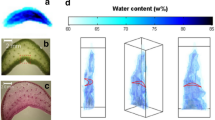Abstract
The basic equations for the evaluation of surface displacement, strain and stress from holographic interferograms are derived. The object shape and the geometry of the optical setup are taken in to account. A corresponding computer program is described. Heterodyne holographic interferometry is used for fringe interpolation (better than 1/1000 of a fringe) to get sufficient accuracy and spatial resolution. Errors and accuracy of holographic strain and stress determination are discussed with the aid of the computer program. A cylindrical tube under pressure load is presented as a numerical example.
Similar content being viewed by others
References
See, e. g., Collier, R.J., Burckhardt, Ch.B. andLin, L.H., Optical Holography, Academic Press New York (1971).
Schumann, W., “Some Aspectes of Optical Techniques for Strain Determination,”Experimental Mechanics,13 (6),225–231 (Jun.1973).
Taylor, L.H. andBrandt, G.B., “An Error Analysis of Holographic Strains Determined by Cubic Splines,”Experimental Mechanics,12 (12),543–548 (Dec.1972).
Dändlicker, R., Ineichen, B. and,Mottier, F.M., “High Resolution Hologram Interferometry by Electronic Phase Measurement,”Opt. Commun. 9 (4),412–416 (Dec.1973).
Dändliker, R., Ineichen, B. andMottier, F.M., “Electronic Processing of Holographic Interferograms,”Proc. International Computing Conferences, IEEE Inc., New York, 69–72 (1974).
Dändliker, R., Eliasson, B., Ineichen, B. andMottier, F.M., “Quantitative Determination of Bending and Torsion Through Holographic Interferometry,”The Engineering Uses of Cohenerent Optics, ed. by E.R. Robertson, Cambridge University Press, Cambridge 99–117 (1976).
Sollid, J.E., “Holographic Interferometry Applied to Measurements of Small Static Displacement of Diffusely Reflecting Surfaces,”Appl. Optics,8 (8),1587–1595 (Aug.1969).
Bijl, D. andJones, R., “A New Theory for the Practical Interpretation of Holographic Interference Patterns Resulting from Static Surface Displacement,”Optica Acta,21 (2),105–118 (Feb.1974).
Dhir, S.K. andSikora, J.P. “An Improved Method for Obtaining the General Displacement Field from a Holographic Interferogram,”Experimental Mechanics,12 (7),323–327 (July1973).
Pryputniewicz, R. andStetson, K.A., “Holographic Strain Analysis: Extension of Fringe Vector Method to Include Perspective,”Appl. Optics 15 (3),725–728 (Mar.1976).
Ek, L. andBiedermann, K., “Analysis of a System for Hologram Interferometry With a Continuously Scanning Reconstruction Beam,”Appl. Optics,16 (9),2535–2542 (Sept.1977).
Crane, R., “New Developments in Interferometry. V. Interference Phase Measurement,”Appl. Optics,8 (3),538–542 (Mar.1969).
Dändliker, R., Marom, E. andMottier, F.M., “Two-Reference-Beam Holographic Interferometry,”J. Opt. Soc Am.,66 (1),23–30 (Jan.1976).
Dändliker, R. and Ineichen, B., “Quantitative Strain Measurement Throught Holographic Interferometry,” 3rd European Electro-Optics Conf., SPIE vol. 99, Soc. Photo-Optical Instr. Eng., Washington, 90–98 (1977).
Ineichen, B., Dändliker, R. andMastner, J., “Accuracy and Reproducibility of Heterodyne Holographic Interferometry,”Applications of Holography and Optical Data Processing ed. by E. Marom.,A.A. Friesem andE. Wiener-Avnear, Pergamon Press, Oxford, 207–212 (1977).
Dändliker, R., “Quantitative Strain Measurement Through Holographic Interferometry,”,169–181.
Szabo, I., Höhere Technische Mechanik, Springer-Verlag, Berlin, 160–165 (1964).
Author information
Authors and Affiliations
Additional information
was associated with Brown Boveri Research Center, CH-5405, Baden, Switzerland at time paper was prepared
Rights and permissions
About this article
Cite this article
Dändliker, R., Eliasson, B. Accuracy of heterodyne holographic strain and stress determination. Experimental Mechanics 19, 93–101 (1979). https://doi.org/10.1007/BF02324197
Received:
Revised:
Issue Date:
DOI: https://doi.org/10.1007/BF02324197




